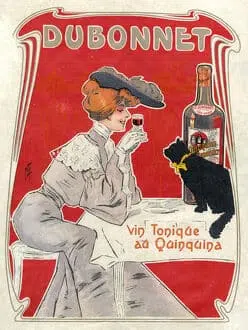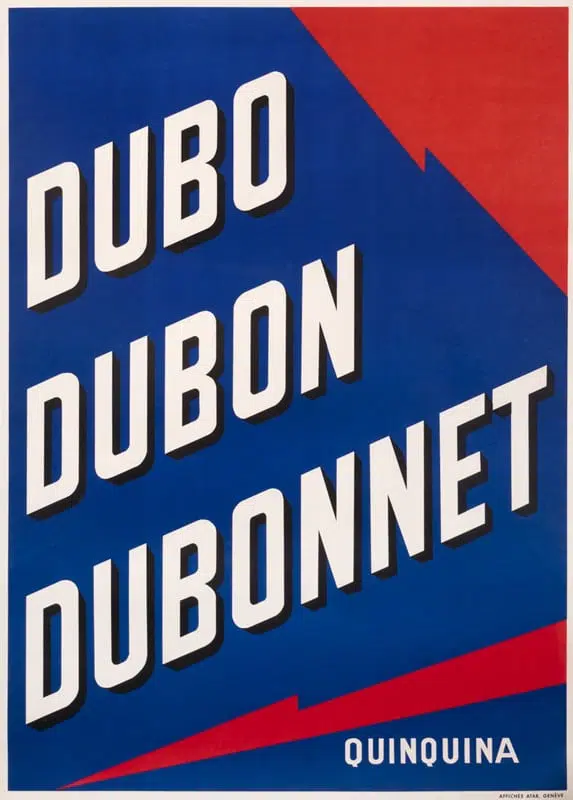Dubonnet is a sweet, red, fortified wine of 14.8% alcohol invented in 1846 by French chemist Joseph Dubonnet. It's typically consumed as an aperitif, digestif, or in the famous Dubonnet cocktail with Gin.
The aromatized wine is made from the grape varieties Ruby Red, Cabernet, and Muscat of Alexandria and flavored with herbs, spices, and a small amount of quinine. The red aperitif belongs to the category of fortified wines. That means the wine base is mixed with a distilled spirit to increase the alcohol content.
However, in the past, the alcohol content was gradually reduced from 18% to 16% and then to 14.8%. The red wine base is spiked with Brandy and aromatized with herbal and spicy ingredients.
Dubonnet is intensely sweet and has a thick, almost syrup texture. It tastes sweet and fruity with hints of spices, comparable to sweet vermouth.
What is Dubonnet?
Dubonnet is a sweet fortified red wine of 14.8% ABV produced in France and the US. It's traditionally served as an aperitif before a meal but also as a digestif. One of the essential ingredients of the fortified wine is the bark of the cinchona tree.

Cinchona bark contains the bitter-tasting alkaloid called quinine. Consequently, Dubonnet belongs to the quinquina group of beverages - aromatized wines containing cinchona bark. It is even one of the most prominent representatives of this group, together with Cocchi Americano and Lillet.
Quick Facts
- Produced by: Pernod Ricard
- Origin: France
- Released: 1846
- ABV: 14.8% (29.6 proof)
- Price: $15
- Color: Purple-red color
- Taste: Sweet, fruity, and slightly bitter with hints of spices
- Best serve: Chilled in a port wine glass
How does Dubonnet taste?
The taste of Dubonnet is comparable to other fortified wine products like Sweet Vermouth. It's sweet and fruity with distinct spicy notes, somehow a cross between a Port or Sherry and a herbal liqueur that also adds a slightly bitter note to the drink. When drinking it straight, you can taste a variety of herbal ingredients like thyme, rosemary, fennel, anise, and nutmeg. And it also carries notes of orange zest, cacao, and earthy flavors.
What is Dubonnet made of?
The base of Dubonnet is a red wine made from Rubired, Ruby cabernet, and Muscat of Alexandria grapes. This base wine is then spiked with brandy, sweetened with cane sugar, and flavored with herbs and spices like blackcurrant, various teas, and cinchona bark.
To make a fortified wine, the vintner adds brandy to the red wine base to stop the fermentation process early. The spiked wine is then flavored and aromatized with herbs and other ingredients like cinchona bark.
The best way to drink Dubonnet?
Served as a digestif it's best to drink Dubonnet chilled or on the rocks. Serve it in a Sherry or Port wine glass at a temperature of 10°C. Sometimes it's also served on the rocks, but the ice dilutes the taste and waters the drink down too much.
Apart from serving it chilled as an aperitif, the best way to drink Dubonnet is probably as an aperitif cocktail.
Dubonnet cocktails
Among all the Dubonnet cocktails, like the Dubonnet Manhattan or the Napolean, none is as beloved as the cocktail the British Royals like to drink.
Queen Elizabeth II and Queen Mum enjoy(ed) the aromatized wine daily. Queen Elizabeth II favors a combination of two-thirds Dubonnet to one-third Gin every day before her lunch. The ingredients are mixed and served over two ice cubes and a slice of lemon.
Her mother chose a similar combination. However, she preferred a tiny bit more in her drink; There's even a cocktail named after her - the Queen Mother.
Here are more cocktail recipes to try with Dubonnet:
Where Does Dubonnet Come From?
The history of Dubonnet started in 1846 when Joseph Dubonnet, a French chemist, took part in a competition run by the French government. The goal of that competition was to create something that would make the French Legionnaires in Africa drink their daily portion of quinine.
Quinine is an effective remedy against malaria, but its taste is bitter and quite unpleasant. So, to hide this bitter taste, Joseph added herbs, spices, and a bit of Brandy. In combination with the sweet red wine base, the taste had been turning out delicious.

Dubonnet was an instant success. First as medication and later on as a leisure drink. And even today, it has a dedicated fanbase, with Queen Elizabeth II having been the most notable one.
In 1976, Pernod Ricard bought the company. This transfer of ownership went along with a re-popularization campaign. The most popular marketing slogan of Dubonnet is still known across the whole of France:
"Dubo, Dubon, Dubonnet"
This tagline roughly translates to "It's nice, it's good, it's Dubonnet". And if you're visiting France, watch out for this phrase on the walls of older houses.
Where is Dubonnet produced?
Since its acquisition by Pernod Ricard, Dubonnet is produced in the French cities of Bordeaux and Lille. Since 1993, the American version is produced by Heaven Hills Distillery in Kentucky. This change was part of a brand relaunch in the US aiming to make the aperitif wine more popular.
FAQs
In the US, a bottle sells for $15 per bottle. In Europe, especially France, you can get it much cheaper at around 8€.
Dubonnet contains 14.8% ABV in France. The US version is significantly stronger and clocks in at 19% ABV.
The famous combination is called a Dubonnet cocktail. The drink is famous for being Queen Elizabeth's (and Queen Elizabeth II's) favorite drink.
You can drink it in cocktails or straight. Either way, Dubonnet should be served chilled as the ideal drinking temperature is at 10°C.
The liqueur was invented by Joseph Dubonnet. In 1976, the company was sold to Pernod Ricard. In 1993, Heaven Hill purchased Dubonnet and is now in charge of the production of the popular fortified wine.
The fortified wine tastes best when it's chilled to mask the sweet flavors. The ideal temperature is between 8-12°C (46-54°F).
Like all fortified wines, Dubonnet should be stored in the fridge once it's opened. You should consume it within eight weeks, otherwise, the flavors will fade.
Final Note
Not only is Dubonnet the favorite drink of Queen Elizabeth II, but it also has been the favorite drink of her mother, Queen Mum. The sweet aromatized wine is an excellent aperitif wine that you should try at least once in your lifetime.

